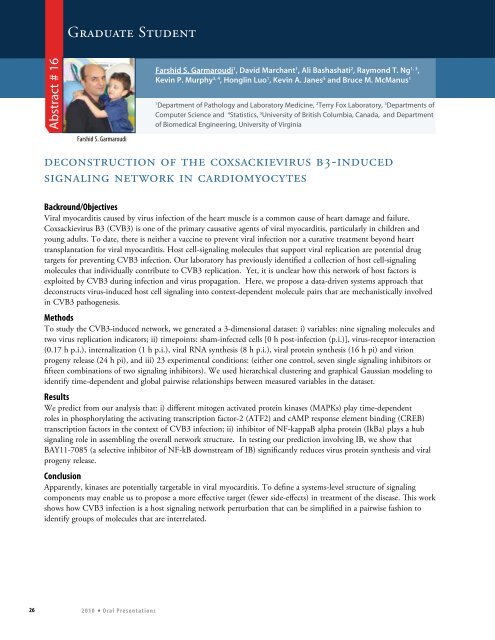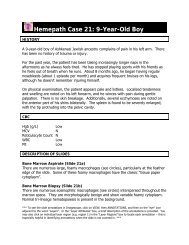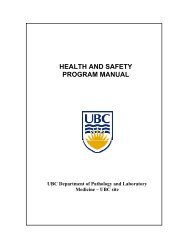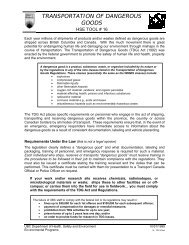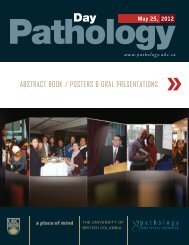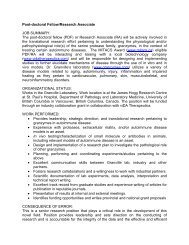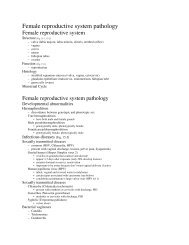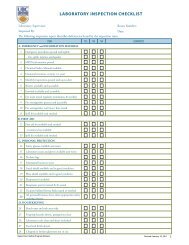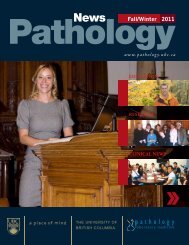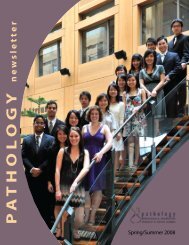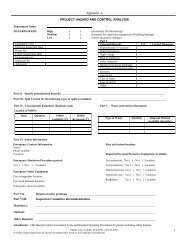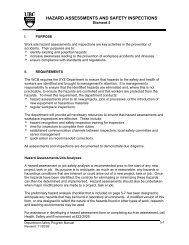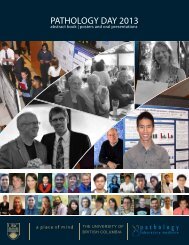Oral Presentations - Pathology and Laboratory Medicine - University ...
Oral Presentations - Pathology and Laboratory Medicine - University ...
Oral Presentations - Pathology and Laboratory Medicine - University ...
You also want an ePaper? Increase the reach of your titles
YUMPU automatically turns print PDFs into web optimized ePapers that Google loves.
Graduate StudentAbstract # 16Farshid S. Garmaroudi 1 , David Marchant 1 , Ali Bashashati 2 , Raymond T. Ng 1, 3 ,Kevin P. Murphy 3, 4 , Honglin Luo 1 , Kevin A. Janes 5 <strong>and</strong> Bruce M. McManus 11Department of <strong>Pathology</strong> <strong>and</strong> <strong>Laboratory</strong> <strong>Medicine</strong>, 2 Terry Fox <strong>Laboratory</strong>, 3 Departments ofComputer Science <strong>and</strong> 4 Statistics, 5 <strong>University</strong> of British Columbia, Canada, <strong>and</strong> Departmentof Biomedical Engineering, <strong>University</strong> of VirginiaFarshid S. Garmaroudideconstruction of the coxsackievirus b3-inducedsignaling network in cardiomyocytesBackround/ObjectivesViral myocarditis caused by virus infection of the heart muscle is a common cause of heart damage <strong>and</strong> failure.Coxsackievirus B3 (CVB3) is one of the primary causative agents of viral myocarditis, particularly in children <strong>and</strong>young adults. To date, there is neither a vaccine to prevent viral infection nor a curative treatment beyond hearttransplantation for viral myocarditis. Host cell-signaling molecules that support viral replication are potential drugtargets for preventing CVB3 infection. Our laboratory has previously identified a collection of host cell-signalingmolecules that individually contribute to CVB3 replication. Yet, it is unclear how this network of host factors isexploited by CVB3 during infection <strong>and</strong> virus propagation. Here, we propose a data-driven systems approach thatdeconstructs virus-induced host cell signaling into context-dependent molecule pairs that are mechanistically involvedin CVB3 pathogenesis.MethodsTo study the CVB3-induced network, we generated a 3-dimensional dataset: i) variables: nine signaling molecules <strong>and</strong>two virus replication indicators; ii) timepoints: sham-infected cells [0 h post-infection (p.i.)], virus-receptor interaction(0.17 h p.i.), internalization (1 h p.i.), viral RNA synthesis (8 h p.i.), viral protein synthesis (16 h pi) <strong>and</strong> virionprogeny release (24 h pi), <strong>and</strong> iii) 23 experimental conditions: (either one control, seven single signaling inhibitors orfifteen combinations of two signaling inhibitors). We used hierarchical clustering <strong>and</strong> graphical Gaussian modeling toidentify time-dependent <strong>and</strong> global pairwise relationships between measured variables in the dataset.ResultsWe predict from our analysis that: i) different mitogen activated protein kinases (MAPKs) play time-dependentroles in phosphorylating the activating transcription factor-2 (ATF2) <strong>and</strong> cAMP response element binding (CREB)transcription factors in the context of CVB3 infection; ii) inhibitor of NF-kappaB alpha protein (IkBa) plays a hubsignaling role in assembling the overall network structure. In testing our prediction involving IB, we show thatBAY11-7085 (a selective inhibitor of NF-kB downstream of IB) significantly reduces virus protein synthesis <strong>and</strong> viralprogeny release.ConclusionApparently, kinases are potentially targetable in viral myocarditis. To define a systems-level structure of signalingcomponents may enable us to propose a more effective target (fewer side-effects) in treatment of the disease. This workshows how CVB3 infection is a host signaling network perturbation that can be simplified in a pairwise fashion toidentify groups of molecules that are interrelated.26 2 0 1 0 * O r a l P r e s e n t a t i o n s


